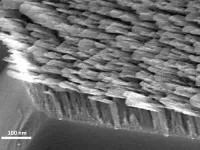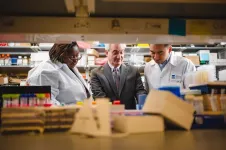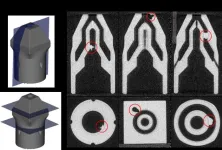(Press-News.org) UNIVERSITY PARK, Pa. — Winters can be tough on managed honey bee colonies, with beekeepers in the United States reporting that one-third of their colonies die each winter. A new study by Penn State researchers has found that using not one but multiple pest treatments may help bees make it to spring.
The researchers found that beekeepers who used a combination of treatments for Varroa mites — tiny parasites that can weaken and spread diseases to honey bees — had higher winter colony survival than those who used only one type of treatment. The findings were published in the Journal of Insect Science.
Additionally, while weather significantly impacted winter colony survival, beekeepers using these integrated pest management strategies — where multiple methods are used to control Varroa mites — had higher colony survival rates even in harsh weather conditions.
Darcy Gray, a global remote sensing manager at the One Acre Fund who led the study while completing her master’s degree at Penn State in the intercollege Ecology Graduate Program administered by the Huck Institutes of the Life Sciences, said she conducted this study to help provide beekeepers with the locally specific information they need to make decisions about how to best manage their colonies to combat these high colony losses during the winter.
“Honey bees pollinate various crops across North America, so it’s important to understand how they're influenced by beekeeping strategies and their environment, particularly under increasing weather variability,” said Gray, who did her graduate research in the lab of Christina Grozinger, Publius Vergilius Maro Professor of Entomology in the College of Agricultural Sciences. “Understanding honey bees’ relationship to the environment can also shed light on and introduce new questions about native bees, which are also threatened by habitat loss and climate change.”
For the study, the researchers used data from an annual survey on winter honey bee colony loss and beekeeping management that has been sent to Pennsylvania beekeepers each spring for more than 15 years.
Data included information on pre- and post-winter colony numbers, how many years of experience the beekeeper had, whether and how they treated for Varroa mites, and whether and what they provided for supplemental feed. Beekeepers also had an option to submit their apiary coordinates, which allowed the researchers to precisely calculate the habitat quality of the landscape surrounding each beekeeper’s hives — including the availability of floral resources in the spring, summer and fall — and to obtain information on the weather conditions that the bees experienced over the previous year.
Grozinger, who also directs the Penn State Center for Pollinator Research, noted that because habitat and weather are complex factors, a lot of data is needed to build statistical models for understanding exactly how they are impacting bees.
“We are so fortunate to be able to work with the Pennsylvania beekeepers, who every year answer a survey on their management practices, their bees’ winter survival and their apiary locations,” Grozinger said. “This provides a truly unique and valuable long term data set for this research.”
The study revealed that beekeepers who used treatments against Varroa mites in their apiaries had significantly higher bee survival than those who did not, and those who used multiple types of treatments had better survival than those who used a single treatment type.
The researchers also found no significant difference between “soft” and “hard” chemical treatments. Soft chemicals — naturally derived, organic compounds — were as effective at increasing winter survival as hard chemicals, which are synthetic chemicals that have been shown to leave long-term residue in colonies and may promote populations of Varroa mites that are resistant to treatment.
These results are consistent with previous studies conducted by Penn State researchers demonstrating that organic beekeeping methods were just as effective as more conventional methods.
Additionally, the researchers found that while spring, fall and winter precipitation was associated with increased bee survival, summer precipitation was associated with decreased colony survival. The researchers suggested this could be because many consecutive days of rain in the summer may reduce the amount of time bees spend foraging, leading to less food stored for the winter and lower brood production.
“This study, along with others from Penn State, shows that the weather conditions during the growing season are really important for honey bee survival and honey production, as well as wild bee species abundance,” Grozinger said. “This suggests that what we are seeing is an effect of weather on the flowering plants that bees depend on for pollen and nectar, and this in turn affects the bees.”
Gray said she hopes the findings will be useful to beekeepers while planning their apiary management strategies, as well as be a springboard for future studies.
“Our work introduces new questions about how colonies treated with an integrated pest management may be buffered from the worst effects of weather, which would have implications for climate change adaptation in beekeeping,” Gray said.
Beekeepers and others interested in exploring the land use and weather conditions and predicting flowering resources at their locations can use the Beescape tool on the Center for Pollinator Research website, which also offers resources on how to improve local habitats for bees, including the Penn State Master Gardener’s Pollinator Garden Certification Program.
The data used in this study can be accessed via the Bee Winterwise tool, and beekeepers also can obtain resources on managing Varroa mites and organic beekeeping practices from Penn State Extension.
Additional authors included Melanie Kammerer, an alumna of the Penn State Ecology Graduate Degree Program and currently an environmental data scientist at EcoData Technology, and Sarah Goslee, a research scientist at the U.S. Department of Agriculture's (USDA) Agricultural Research Service Pasture Systems and Watershed Management Research Unit.
The USDA National Institute of Food and Agriculture supported this research through its Food and Agriculture Cyberinformatics Tools (FACT) Program.
END
Combining pest treatments may be key to helping honey bees survive the winter
2024-06-04
ELSE PRESS RELEASES FROM THIS DATE:
UTA program helps students achieve medical school dreams
2024-06-04
Getting into graduate school to become a doctor or a dentist is difficult. By some estimates, only about 37% to 42% of students who apply to medical or dental school are accepted.
To help pre-medical and -dental students achieve their dreams, UT Arlington created a program called the Health Professions Advisory Committee (HPAC). The odds of graduate school admission for students participating in HPAC is significantly higher than average, with an estimated 85% succeeding.
This is just one of several UT Arlington initiatives helping alleviate ...
Rocky shores of Pacific Northwest show low resilience to changes in climate
2024-06-04
CORVALLIS, Ore. – A 15-year period ending in 2020 that included a marine heat wave and a sea star wasting disease epidemic saw major changes in the groups of organisms that live along the rocky shores of the Pacific Northwest.
The study by Oregon State University scientists, involving four capes in Oregon and California, suggests these communities of species may have low resilience to climate change. Findings were published Monday in Nature Ecology & Evolution and.
Researchers learned that ...
A new way of designing auxetic materials
2024-06-04
Imagine pulling on the long ends of a rectangular piece of rubber.
It should become narrower and thinner.
But what if, instead, it got wider and fatter?
Now, push in on those same ends. What if the rubber became narrower and thinner?
Such common-sense-defying materials do exist. They’re called auxetics, and they have a raft of unique properties that make them well-suited for sneaker insoles, bomb-resilient buildings, car bumpers and clothing.
Despite this great potential, auxetic products have been slow to market. Researchers at the National Institute of Standards and Technology (NIST) and the University of Chicago hope to change this.
In a new study published ...
Neurocognitively-defined subtypes in bipolar disorder: a path to more personalized treatments
2024-06-04
The Brain & Behavior Research Foundation (BBRF) is hosting a free webinar, “Neurocognitively-Defined Subtypes in Bipolar Disorder: A Path to More Personalized Treatments” on Tuesday, June 11, 2024, at 2:00 pm ET. The presenter, Katherine E. Burdick, PhD, is the Jonathan F. Borus, MD Distinguished Chair in Psychiatry and the Vice Chair for Research in Psychiatry at Brigham and Women’s Hospital. She is the Director of the Mood and Psychosis Research Program at BWH and a Professor at Harvard Medical ...
Shining a light on molecules: L-shaped metamaterials can control light direction
2024-06-04
UNIVERSITY PARK, Pa. — Polarized light waves spin clockwise or counterclockwise as they travel, with one direction behaving differently than the other as it interacts with molecules. This directionality, called chirality or handedness, could provide a way to identify and sort specific molecules for use in biomedicine applications, but researchers have had limited control over the direction of the waves — until now.
Using metamaterials, a team of electrical engineering researchers from Penn State and the University of Nebraska-Lincoln ...
Wistar scientists develop novel antibody treatment for kidney cancer
2024-06-04
PHILADELPHIA — (June 04, 2024) — Advanced clear cell renal cell carcinoma (ccRCC) is a deadly form of kidney cancer with few treatment options; even with new immunotherapies, only around one in 10 patients ultimately survive.
Antibody therapies called bispecific T cell engagers (BTEs) have emerged as effective treatments for some blood cancers but have been more difficult to develop for solid tumors. While clinically successful, first-generation BTEs suffer a short half-life. Now, Wistar scientists have built upon BTE technology to develop new and improved recombinant and synthetic ...
Virus that causes COVID-19 can remain in sperm for 110 days after infection
2024-06-04
Researchers at the University of São Paulo (USP) in Brazil have shown for the first time that SARS-CoV-2, the virus that causes COVID-19, can remain in the sperm of patients for up to 90 days after hospital discharge and up to 110 days after the initial infection, reducing semen quality. The study is reported in an article published in the journal Andrology. The authors suggest that people who plan to have children should observe a period of “quarantine” after recovering ...
Researchers use machine learning to detect defects in additive manufacturing
2024-06-04
Researchers at the University of Illinois Urbana-Champaign have developed a new method for detecting defects in additively manufactured components.
One of the most important tasks in any factory is to determine whether a manufactured component is free of defects. In additive manufacturing (3D printing), it can be particularly challenging to find defects, because additive manufacturing can make components that have complex three-dimensional shapes and important internal features that are not easily observed.
The novel technology uses deep machine ...
Rare disease’s DNA-damaging mutation could have consequences for more common conditions
2024-06-04
TREX1 is a gene that is supposed to direct the maintenance of the entire body’s DNA, but new research shows that when people are born with mutated TREX1, it causes catastrophic damage to the DNA over time, resulting in a deadly rare disease called retinal vasculopathy with cerebral leukoencephalopathy (RVCL). Published in Nature Communications, the research was led by teams at the Perelman School of Medicine at the University of Pennsylvania and the Brain Research Institute at Niigata University in Japan.
While it was already known that a mutation in TREX1 was behind RVCL, the mechanism by which ...
Exploring three frontiers in marine biomass and blue carbon capture
2024-06-04
A new study offers first-time insights into three emerging climate innovations to safeguard or increase the carbon naturally captured by ocean and coastal ecosystems: rapid interventions to save the Great Barrier Reef, satellite-tracked kelp beds in the deep ocean, and seagrass nurseries in the United Kingdom. The research, published in Environmental Science & Policy and co-authored by leading climate scholars at Boston University, Aarhus University, and the University of Sussex Business School, advances knowledge of understudied interventions in marine ...







